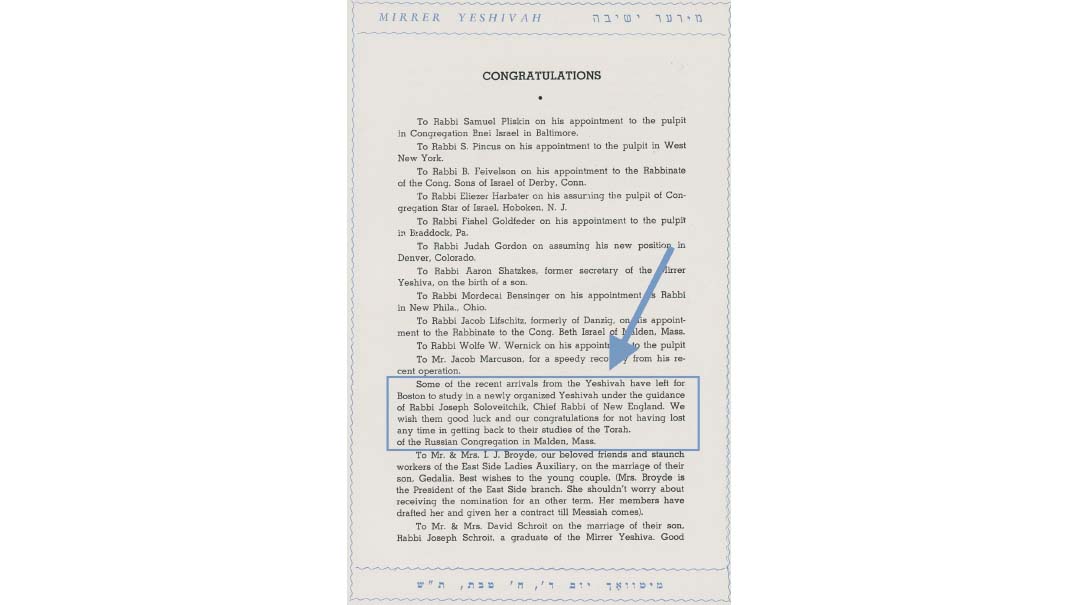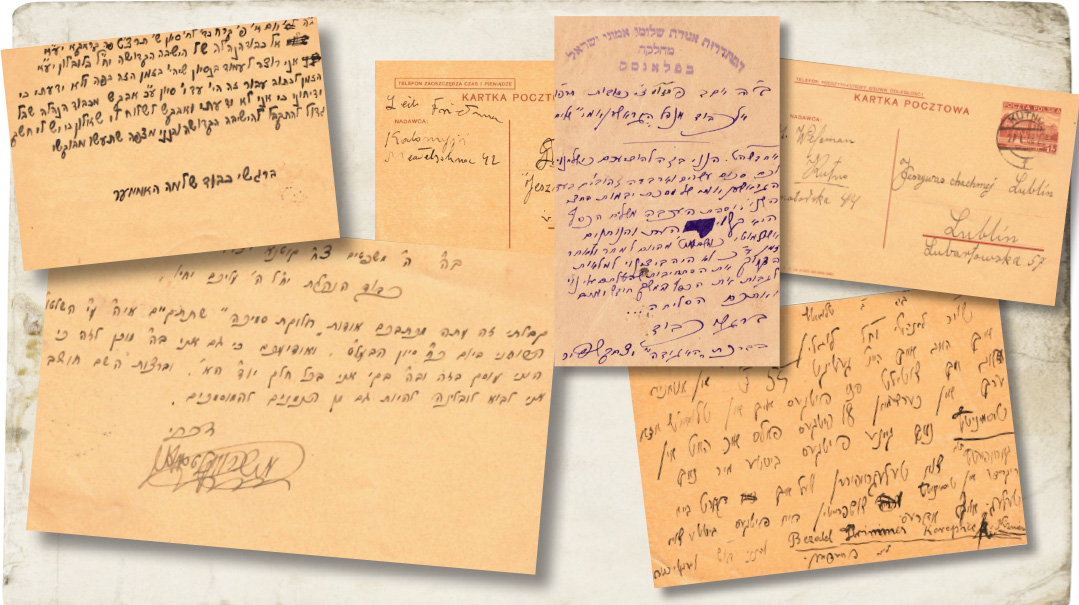The Boston Torah Party
| October 26, 2021Brisk in Boston

Title: The Boston Torah Party
Location: Boston, Massachusetts
Document: Mir Yeshivah Dinner Journal
Time: 1939
Rav Chaim Brisker’s impact upon the Lithuanian Torah world is almost immeasurable. Students of his in the Volozhin yeshivah went on to lead some of the most prestigious prewar yeshivos, and his name became synonymous with the new analytical approach to learning that electrified the yeshivah world for generations to come. In addition to his transformative impact on the way Gemara is studied, there were tangible memorials to him in the form of yeshivos that carried his name.
Shortly following the passing of Rav Chaim in 1918, Yeshivah Toras Chaim in Warsaw was named for him. Loosely affiliated with Rav Itche Grodzenski's network of Torah institutions in Poland’s capital, the Toras Chaim yeshivah was headed by Rav Chaim Brisker’s son-in-law Rav Hirsh Glikson. Rav Yitzchok Zev Soloveitchik, the Brisker Rav, taught there for a short time as well prior to succeeding his father in the Brisk rabbinate. Toras Chaim served as one of the leading yeshivos in the city until they perished in Treblinka with the rest of Warsaw Jewry during the Holocaust.
Migrating from Warsaw to the United States was another branch of Rav Chaim’s family. Rav Moshe Soloveitchik was firmly ensconced as the rosh yeshivah of RIETS by 1929, and his son Rav Yosef Dov Soloveitchik was appointed rabbi in Boston a couple of years later. With the encouragement of his father, Rav Soloveitchik opened a yeshivah in Boston named Heichal Rabbeinu Chaim HaLevi (also known as the Boston Yeshivah) in 1932. The yeshivah functioned similarly to today’s community kollel, with an emphasis on learning and shiurim for laymen and their children.
In late 1939, the Heichal grew in both size and stature, thanks to a cadre of new arrivals, at whose core stood 15 American-born European-educated (primarily Mir) yeshivah students who had returned with the outbreak of the war. They were joined by several European-born counterparts who were able to escape, as well as a few “Yankees.” In late 1941, Rav Michel Feinstein, one of the “Lions of Mir,” arrived on American shores and joined the group. In what was colloquially known as “the Kibbutz,” Rav Michel delivered shiurim during the week, while Rav Soloveitchik delivered shiurim over the weekend. At times his Motzaei Shabbos shiur would go through the night, concluding with the arrival of daylight.
The yeshivah was assisted by local balabatim who were schooled by the Rav on the importance of “Torah lishmah.” This was evident in a passionate plea to Jewish Bostonians penned by Rav Soloveitchik’s brother-in-law, Edward Gerber, in the pages of the local Jewish Advocate:
Because the foreign Yeshivoth have constantly been a source of religious leaders to serve in our various Jewish institutions, the American Jewish public has become lax and has taken it for granted that there is a permanent unfailing source of Talmidei Chachomim. This vast public must be made aware that the old order has changed and now we must train our own scholars and leaders.
However, even though it is important to train leaders and rabbis, it is of even greater importance to train an intelligent Jewish laity. Unfortunately, there is a common widespread fallacy in the minds of many of our co-religionists that Jewish education is of importance only to those who desire to enter the rabbinate. Even a brief survey of the history of Jewish communities and various movements, even secular, will show that, on the average, people who have been active were people who have had good Talmudic training.
The endeavor to revitalize the Jewish consciousness of the American Jew is destined to fail as long as the Jewish educational level is not raised, for there is no active Judaism without profound Talmudic knowledge being widespread. It is planned that this newly founded Torah center will serve this purpose.
The prominence of this short-lived institution was displayed by visits from Rav Aharon Kotler and Rav Chaim Heller, who delivered shiurim in front of large crowds that included Massachusetts’s rabbinic leaders, among them Rav Avigdor Miller, whose father-in-law, Slabodka talmid Rav Yaakov Moshe Lessin, delivered schmuessen there. Efforts were made to expand the prodigious hanhalah, including an attempt to lure Rav Elya Lopian from England to serve as mashgiach.
Among those who studied at the Heichal were Rabbi Shachne Zohn, Rabbi Shamshon Brodsky, Rabbi Shmuel Sheinberg, Rabbi Henoch Cohen, Rabbi Pesach Cohen, Rabbi Yisroel Shurin, Rabbi Yeshaya Miller, and Rabbi Nota Greenblatt. Rav Nota recalled the intensive Torah study despite the primitive physical conditions. The dormitory was situated in an abandoned house, with broken windows and no heat. Rav Nota would often prepare water to wash his hands in the morning, and it would freeze over in the harsh New England winter. Yet the learning continued uninterrupted.
Another talmid recalled the surreal experience of studying Rav Chaim’s Torah from the original manuscripts, which Rav Soloveitchik would occasionally make available. Later he’d only allow them to peruse the notes with their hands behind their back, lest they damage the rare treasures.
In 1940 a memorandum of affiliation was reached between the Heichal and RIETS, which had the potential to turn it into a postgraduate kollel of the New York yeshivah and thus help its finances and provide a pipeline of new talmidim. These plans were derailed by the 1941 death of Rav Moshe Soloveitchik and subsequent hiring of his son to fill his place, after which the Heichal was shuttered.
Staying Soloveitchik
After the Heichal disbanded, Rav Michel Feinstein joined his uncle Rav Moshe Feinstein in Mesivta Tiferes Yerushalayim (MTJ) on the Lower East Side. In 1946, he married Lifsha Soloveitchik, the daughter of his rebbi, the Brisker Rav. After returning to MTJ for five years, they moved to Israel in 1952 and Rav Michel opened Yeshivah Beis Yehuda in Tel Aviv. In 1973 he moved the yeshivah to Bnei Brak, where he resided until his passing at 97 in 2003.
Boston Yeshivos Abound
In the mid-’50s, with the encouragement of Rav Aharon Kotler and Rav Nosson Wachtfogel, along with the patronage of renowned Boston rabbinic leader Rav Shlomo Margolis, Rav Leib Heyman and Rav Gedaliah Anemer opened a mesivta in Boston. Known as the Boston Rabbinical Seminary, the out-of-town-style yeshivah reached peak enrollment of 300 in the late ’50s, and, with the encouragement of Rav Margolis and the Bostoner Rebbe, Rav Levi Yitzchok Horowitz, it enjoyed the strong support of the local community. Its talmidim included Rav Malkiel Kotler; Rav Dovid Nojowitz, national director of Torah Umesorah; and Rav Moshe Sorotzkin, founder of Telz Stone.
For more on the story of Yiddishkeit in Boston, see the Jewish History Soundbites "Great American Jewish Cities" mini-series on Boston at YehudaGeberer.com/Podcast.
(Originally featured in Mishpacha, Issue 883)
Oops! We could not locate your form.







